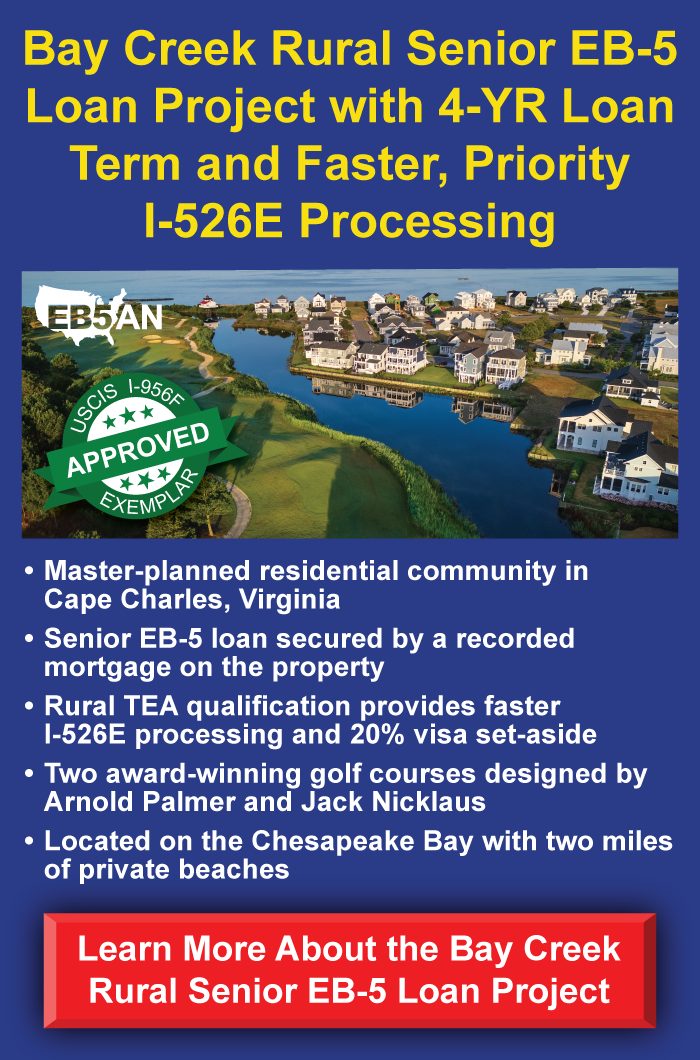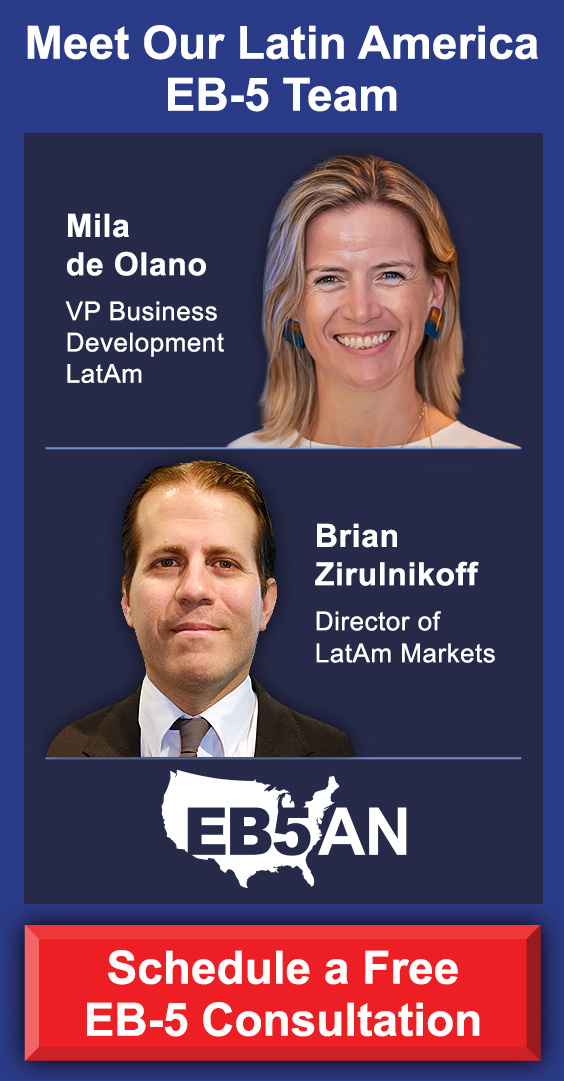For non-citizen immigrants in Canada seeking permanent residency in the United States, the EB-5 Immigrant Investor Program offers an attractive and efficient pathway.
The EB-5 program allows foreign nationals (including those living in Canada) and their families to secure U.S. Green Cards through a qualifying investment in a job-creating new commercial enterprise.
This article will discuss how immigrants or legal permanent residents in Canada can leverage the EB-5 visa to achieve their U.S. residency goals, and explain key concepts like country of chargeability.
The EB-5 Visa: A Pathway to U.S. Permanent Residency
Key Requirements for the EB-5 Visa
The Role of Country of Chargeability in the EB-5 Program
Do PR Holders in Canada Qualify for a TN Visa?
Advantages of the EB-5 Program for Immigrants in Canada
EB5AN Can Help Immigrants in Canada Become Green Card Holders
The EB-5 Visa: A Pathway to U.S. Permanent Residency
The EB-5 visa permits foreign investors and their families to obtain permanent residency (Green Cards) by making a $1,050,000—or $800,000 for targeted employment areas—investment in a U.S. new commercial enterprise that creates at least 10 full-time jobs for U.S. workers.
The key benefit of the EB-5 program is that it provides a direct path to a Green Card without the need for employer or family sponsorship, making it a particularly appealing option for a wide range of prospective applicants.
The EB-5 program is also a viable option for lawful permanent residents of Canada who want to establish themselves in the U.S. and are looking for a path to U.S. citizenship. It does not require the applicant to work for a U.S. employer or to be sponsored by a family member, as is the case with many other visa types.
Key Requirements for the EB-5 Visa
To qualify for the EB-5 program, applicants’ investments must meet the minimum amount threshold, be used for job creation, and remain at risk for the required period.
Investment Amount
The applicant must invest at least $1,050,000 in a U.S. new commercial enterprise. However, if the investment is made in a targeted employment area (TEA), the required investment is reduced to $800,000.
TEAs fall into two main categories: rural and high unemployment. To qualify as a rural TEA, the project must be in a location outside of a metropolitan statistical area that has a population below 20,000. Conversely, to qualify as a high-unemployment TEA, the project must be in an area with an unemployment rate at least 150% of the national average.
The TEA designation is an important consideration for many EB-5 investors, as it lowers the financial barrier to entry.
Job Creation
To meet the program’s requirements, an EB-5 investment must create at least 10 full-time jobs for U.S. workers within two years.
If the investor invests through a regional center (a USCIS-designated organization that manages investments), the job creation can include both direct and indirect jobs, making it easier to reach the required amount.
At-Risk Investment
The investment must be “at risk,” meaning that it must be a true investment into a business, not just a loan or a passive investment. The funds must be used in a way that supports the enterprise and its operations, and there must be no guarantee of a return on the investment.
Once these criteria are met, immigrants in Canada can apply for the EB-5 visa and seek U.S. permanent residency for themselves, their spouses, and children under 21.
The Role of Country of Chargeability in the EB-5 Program
One important concept that potential EB-5 investors must understand before beginning their immigration journey is the country of chargeability.
The reason a person’s country of chargeability is so important is because the EB-5 visa is subject to annual quotas based on the applicant’s country of origin. As a result, a person’s country of chargeability determines their visa availability.
Country of Chargeability: What Does It Mean?
Your country of chargeability refers to the country under which you are counted for U.S. immigration purposes. It is important to note that your country of chargeability is determined by your place of birth, not your current country of citizenship or residence.
For example, if an individual is a Canadian citizen but was born in India, their country of chargeability for the EB-5 visa would still be India. This is significant because the United States applies visa quotas for each country, and countries like India and China often experience visa backlogs due to their high demand for Green Cards.
Reserved visa set-asides have significantly reduced Green Card waiting times for eligible EB-5 applicants. However, new retrogression is expected in certain set-aside categories, so individuals who live in Canada but were born in India or China are encouraged to begin the EB-5 process as soon as possible—before the Visa Bulletin reflects any retrogression in these categories.
Canadian permanent residents born in India or China may want to prioritize low-risk rural EB-5 projects to minimize future backlog risks. Partnering with an experienced immigration attorney can also help maximize both immigration and financial success.
Do PR Holders in Canada Qualify for a TN Visa?
The TN visa allows Canadian and Mexican professionals to work temporarily in the U.S. in certain skilled occupations.
Importantly, though, the TN visa is not a dual-intent visa. This means that TN visa holders are expected to have the intent to remain temporarily in the U.S. and are not supposed to seek permanent residency while on this visa.
Although the TN visa is not a dual-intent visa, it is still possible for TN visa holders to switch to the EB-5 program. However, applicants should pay careful attention to the planning and timing aspects of this switch so that they aren’t deemed to be in violation of their visa.
Also, this visa route available to Canadian-born or naturalized Canadian citizens is not available to lawful permanent residents of Canada. Immigrants in Canada who are not Canadian citizens are not eligible for TN status in the U.S.
Advantages of the EB-5 Program for Immigrants in Canada
The EB-5 program offers several advantages for immigrants in Canada who are seeking permanent residency—and eventual citizenship—in the U.S.
Direct Path to Permanent Residency
Unlike other work visas, such as the H-1B, the EB-5 visa provides a direct path to a U.S. Green Card for the investor and their family.
And unlike many other employment-based immigrant visa categories, the EB-5 visa does not require employer sponsorship or specific job skills. This provides flexibility for investors who want to start their own business in the U.S. or have more employment freedom.
Set-Aside Visas
With the visa set-aside categories for investments in TEAs, immigrants from countries with high demand for U.S. Green Cards (like India or China) can benefit from shorter waiting times for their EB-5 petitions.
And all investors, no matter their country of chargeability, can benefit from the lower investment threshold offered by TEA projects.
Family Inclusion
The EB-5 program allows the investor’s spouse and unmarried children under 21 to also obtain Green Cards, making it an ideal route for entire families seeking U.S. permanent residency.
EB5AN Can Help Immigrants in Canada Become Green Card Holders
One of the biggest advantages for Canadian permanent residents moving to the United States is how seamless the transition can be. The U.S. shares many cultural, economic, and social similarities with Canada—both are English-speaking countries with strong, diverse economies and well-established immigrant communities. This makes it easier for newcomers to find familiar systems, support networks, and professional opportunities already in place.
The business environment in the U.S. is also very similar to Canada’s, which helps entrepreneurs and investors adjust more easily. Many Canadian PR holders are already used to North American standards in areas like finance and education, which makes settling in even smoother. With the added benefit of a Green Card for the investor and their immediate family, the EB-5 visa offers a practical and strategic path to building a long-term future in the U.S.—as long as it’s done with guidance from experienced professionals.
EB5AN has helped more than 2,300 families from 70 countries relocate to the United States as lawful permanent residents. Our team has more than a decade of experience, and we offer our clients low-risk EB-5 regional center projects with a 100% USCIS project approval rate.
If you would like to know more about your EB-5 investment options as a Canadian permanent resident, book a free call with our expert team today.










